As a beginner, choosing the right chicken breed to raise on a small farm or even in the backyard is fairly important.
Some people tend to favor the larger breeds that could provide them with a good amount of meat. Some prefer to raise their chickens for the eggs. While others just want to keep their backyard lively with birds running around.
The good news is you have many to choose from. In fact, there are a few breeds that are great layers, easy to handle, and also are great ornamental pets.
In this article, we will explore the 17 best chicken breeds for beginners.
1. The Leghorns
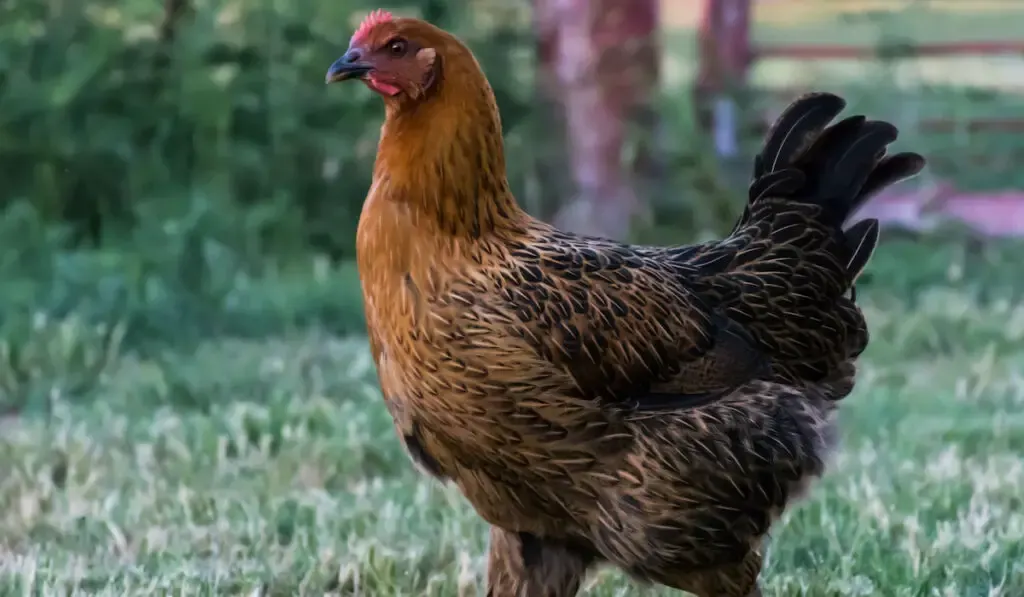
The Leghorn chicken originated from the Leghorn port located in Northern Italy.
At first, Leghorns were smaller in size when they arrived in the United Kingdom. Then Englishmen began to cross them with the Minorca breed. Today’s version of the Leghorns is bigger than the former version.
They were exported to the United States in 1828 by a man named Captain Gates.
These chickens are easy to recognize. They have red wattles, single or rose combs, red to orange eyes, yellow skin, beaks, and legs.
The Leghorns come in different colors depending on their varieties. These include white, buff, brown, and dark brown. The roosters generally weigh between 7.5 and 8 pounds while the hens weigh between 5 and 6 pounds.
This breed is suitable for beginners because they are great layers and able to produce 3 to 4 white eggs per week.
Furthermore, they are calm, docile, and able to forage for food on their own. Minimal supervision is required for the Leghorns.
2. The Rhode Island Red
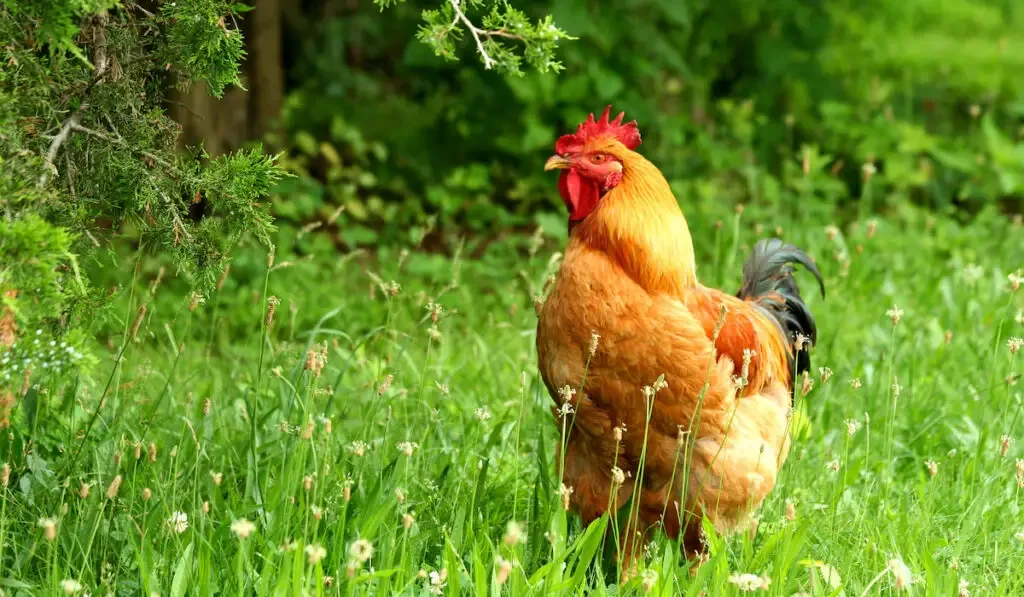
The Rhode Island Red chickens are one of the go-to chickens to be raised in the backyard. This breed originated in the New England states of Massachusetts and Rhode Island.
In 1904, they were recognized by the American Poultry Association for the single comb and the rose comb in 1906. This breed inherits most of their prominent bright colors and their rose comb from the Malay and the black-red Java breeds that are part of their background.
The primary color of the Rhode Island Red is a shiny, dark chestnut red. Their plumage can sometimes range from a dark rust red to a deep maroon. They also have yellow legs, shanks, and beaks with iridescent dark green tail feathers.
The roosters generally weigh around 8.5 pounds while the hens weigh around 6.5 pounds. The hens are great layers and can lay between 5 to 6 eggs per week or up to 300 eggs per year.
Beginners often choose these chickens because they are hardy and resistant to most diseases. Plus, this breed is relatively calm and easy to handle.
3. The Plymouth Rock
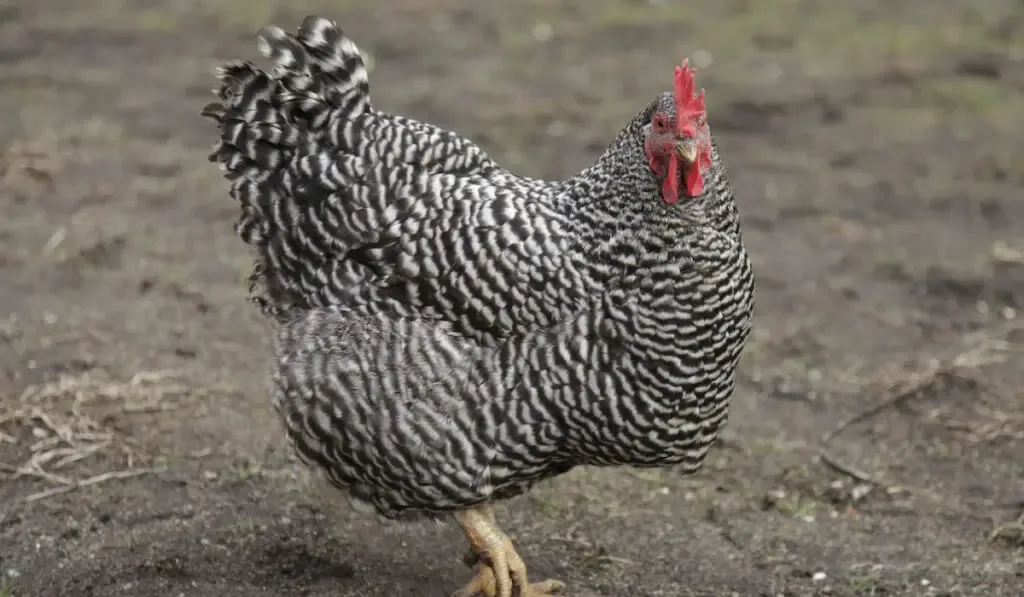
Being one of the oldest chicken breeds, the Plymouth Rock’s origin can be traced back to the time when they first arrived in Massachusetts in 1849.
One man from Worcester named Mr. Upham began to cross a few different breeds like the Dominique, the Java, the Cochin, and the Brahma to produce this breed. The first generation of the Plymouth was barred and later, different varieties were developed.
The Plymouth Rocks possess distinctive plumage with ‘black and white bars’. While the roosters have equal black and white barring, the hens have slightly wider black bars than the whites.
These chickens also have yellow skin and legs with a five-point single comb. Mature roosters generally weigh around 9.5 pounds and the hens weigh around 7.5 pounds.
This breed is definitely suitable for beginners because of its calm, docile, and easy-going temperament. Plymouth Rock chickens also aren’t that noisy and don’t fly well.
The hens are great layers and able to lay between 4 and 5 light-brown eggs per week. Considered as a dual-purpose, they can also be raised for their meat.
4. The Cochin
The Cochin originated from the Shanghai province in China. In the 1800s, they were further developed from Chinese Shanghai fowl in Britain and America.
The Chinese developed and raised Cochin chickens for their meat and eggs. Luckily, due to their unique appearance and fluffy feathers, people also began to adopt them as ornamental chickens.
From afar, the Cochins can easily be spotted by their fluffy thick feathers. These large fowl come in different varieties and colors like white, black, brown, blue, barred, buff, and many more.
They also have a single comb with red wattles and earlobes. The roosters generally weigh around between 10 and 11 pounds and the hens weigh around 8.5 pounds.
Cochin chickens are beginner-friendly. They are docile, calm, and laid back. They don’t mind living in a small space in the backyard and get along well with children.
The hens are also great layers and typically lay between 2 and 3 brown eggs per week. Unlike other chickens, this breed isn’t noisy.
5. The Easter Egger
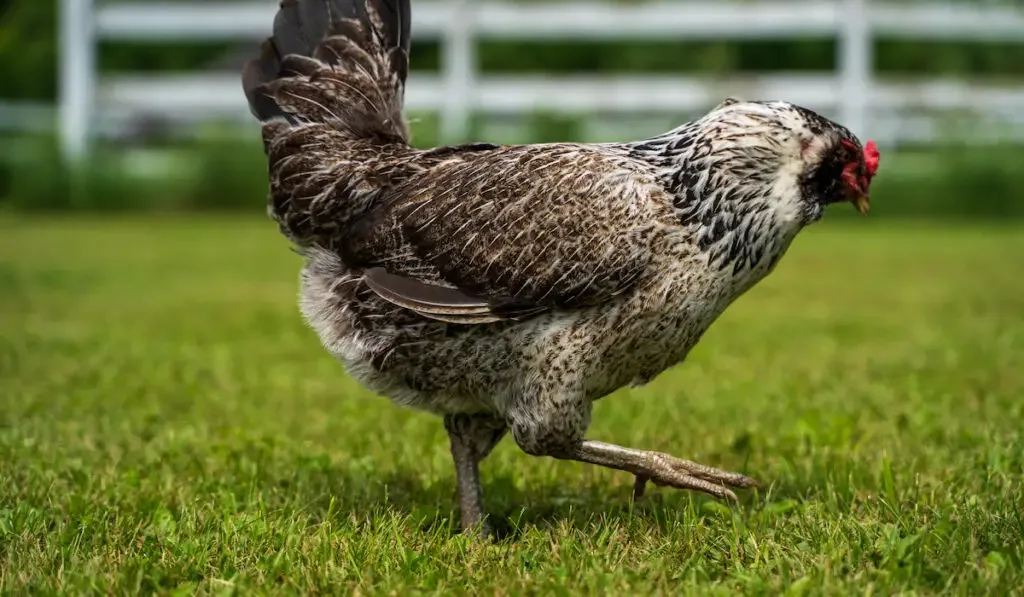
These hybrid chickens have their own place in people’s hearts. Known for their beautiful rainbow-colored eggs, the Easter eggers inherited their genetics from two different breeds: the Araucana and the Ameraucana.
In the 1930s, Araucana chickens were brought from Chile to the United States before they were crossed with Ameraucana chickens to produce this breed.
The Easter Eggers aren’t specific to just one variety with the same physical characteristics. They come in mixed colors that look blotchy and random. Some of them have red or white earlobes. The color of their legs also varies from yellow to green.
Even the roosters can look similar to the hens. The only way to differentiate between those two is through their behavior. Hens will be calmer and quieter while the roosters are more active and noisy.
Roosters generally weigh around 5 pounds and the hens weigh around 4 pounds. The hens are great layers and able to produce around 4 bluish eggs per week.
The Easter Eggers are definitely suitable for beginners. They can withstand changing climates and are extremely resistant to diseases and parasites. These chickens are also docile, get along easily with humans, and are friendly with other animals.
6. The Buff Orpington
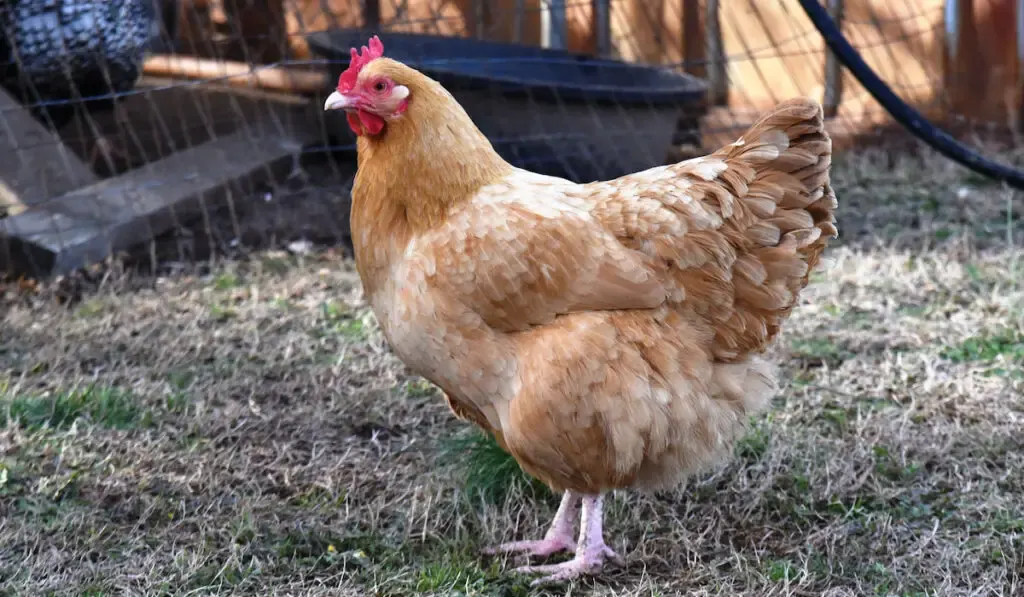
The Buff Orpingtons are native to the region in southeast England. In the late 19th century, this breed was developed by William Cook of Orpington, Kent, when he crossed three different breeds: the Minorcas, the Langshans, and the Plymouth Rocks.
In 1886, he finally announced the first Black Orpington breed, followed by other varieties with different colors like white, buff, blue, and splash.
These chickens possess rounded and plump bodies, single medium to large-sized combs, red wattles, and short pinkish legs. The roosters generally weigh between 8 and 10 pounds while the hens weigh between 6 and 8 pounds.
Most of today’s Orpington come in buff color but bantam varieties could come in other unique colors like red, blue-laced, black-white laced, birchen, and buff Colombian.
The Buff Orpingtons are docile and easy to handle. This is one of the top reasons why beginners won’t have any problems with them.
Plus, these chickens aren’t easily startled and can get along well with children. The hens are also great layers and able to lay between 3 and 5 light brown eggs per week.
7. The Silkie
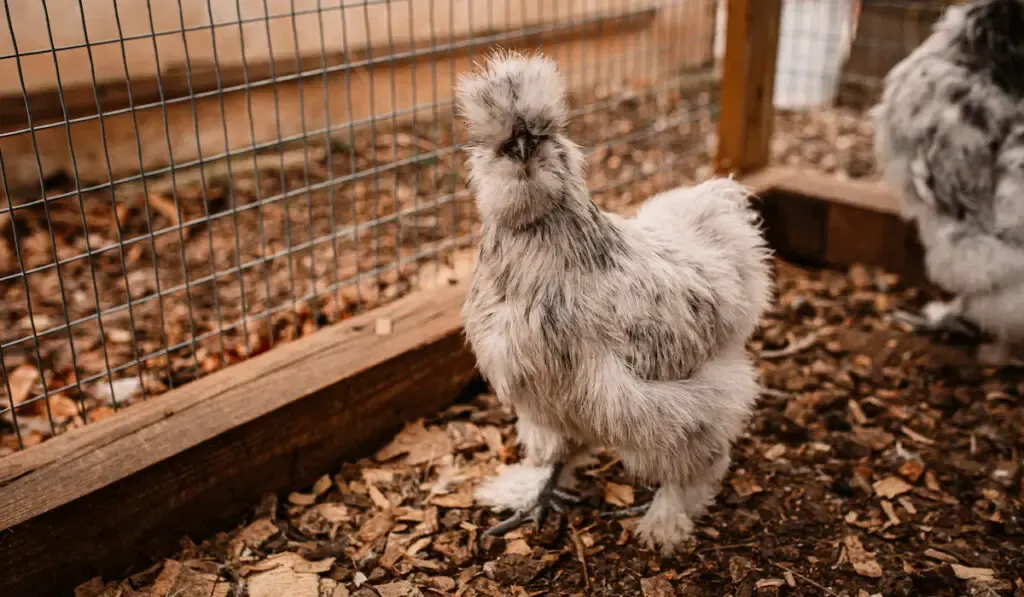
Also known as the Silk or Chinese Silk chicken, this breed originated from China and other places in Southeast Asia.
In the 1800s, they were brought to Europe and quickly become one of the more popular ornamental birds. Back The Chinese originally raised Silkie chickens for their black meat and bones for magical and medicinal purposes.
The Silkies possess beautiful, fluffy feathers with crested ‘pom-pom’ heads, black to dark red walnut-shaped combs, light blue earlobes, rounded bodies, and gray legs.
The American Poultry Association recognizes 8 colors for different Silkie varieties such as black, buff, gray, white, splash, lavender, and partridge.
The roosters generally weigh between 2 and 3 pounds while the hens weigh between 1.5 and 2 pounds. Bantam Silkies are much lighter, which is around 32 and 35 ounces.
Due to its docile and friendly nature, this breed is definitely suitable for beginners. They are easy to tame and able to get along with children.
Unlike other breeds, the Silkies aren’t prolific layers. They can only lay between 2 and 3 eggs per week. Aside from that, they do make great pets.
8. The Australorp

The Australorps or the Black Australorp chickens are native to Australia. They were developed from the Black Orpington in the 1800s and first imported to the United States in the 1920s.
Further development to improve their traits was done by crossing this breed with other breeds like White Leghorn, Rhode Island Red, Minorca, and Langshan. As a dual-purpose breed, the Australorps are raised both for their meat and eggs.
These chickens can be recognized by their glossy black plumage, red wattles, large red combs, dark beaks and legs, and four toes on each foot. Mature roosters generally weigh between 6 and 8 pounds and the hens weigh between 5 and 7 pounds.
Beginners can opt for this breed because they are docile, calm, and easy to raise. The Australorps are also fast growers and make great free-ranging fowl for people with small backyards.
The hens are prolific layers of between 5 and 6 light brown eggs per week, which sums up to almost 364 eggs per year.
9. The Jersey Giant

The Jersey Giants are the largest chicken breed in this world. Originating in the town of Jobstown, New Jersey, these chickens were developed in the 1870s by John and Thomas Black by crossing three different breeds: the Black Java, Black Langshan, and Brahma.
This breed was first called ‘The Giant’. However, to honor the brothers who were responsible for this magnificent fowl, they are called the ‘Black Giant’. Then, final changes were made by Dexter P. Upham when he named them the ‘Jersey Giants’ to represent their place of origin.
These large birds possess iridescent greenish-black plumage, red wattles, a single comb, and dark legs with four toes and yellow soles. Roosters generally weigh between 13 and 15 pounds with a height of around 22 to 26 inches. Hens weigh around 11 pounds with a height of around 16 to 20 inches.
Although they are slow-growers, these chickens are raised for their meat and eggs. The hens are great layers and able to lay between 2 and 4 light brown eggs per week.
Although they are larger than other breeds, the Jersey Giants are definitely suitable for beginners. They are friendly, gentle, and get along well with humans and other chickens.
10. The New Hampshire
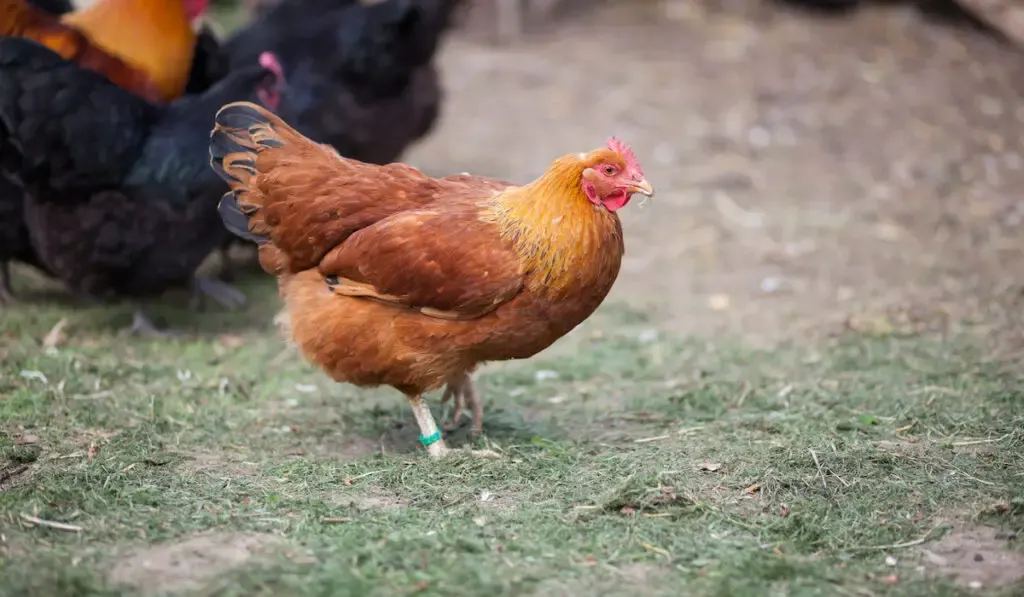
Like their name, these chickens were developed in New Hampshire, the United States in 1910. The only reason why they look similar to the Rhode Island Red is that this breed was used during the development of the New Hampshire.
Compared to their descendant, the New Hampshires grow faster, the chicks produce feathers at a faster rate, and mature earlier.
These chickens have chestnut red or golden red plumage, medium to large-sized combs, and wattles, with yellow shanks, legs, and toes. The roosters generally weigh around 8 pounds while the hens weigh around 6 pounds. As a dual-purpose breed, they are raised for their meat and eggs, which average 3 to 4 a week
The New Hampshire is definitely a beginner-friendly breed. They are docile and easy to tame.
11. The Sussex
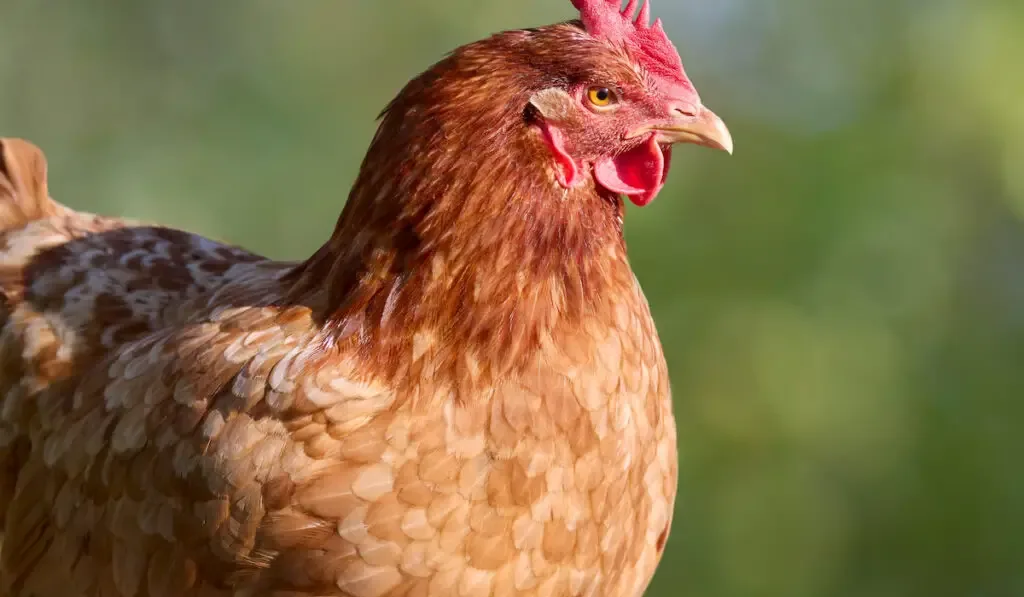
As one of the most popular chicken breeds in England, the Sussex chickens were developed more than 100 years ago from native fowl found in the Sussex region.
They first arrived in the United States in 1912 before being recognized by the American Poultry Association in 1914. 15 years later, three other varieties were recognized such as the Red, Speckled, and Light Sussex.
Sussex chickens come in different color variations ranging from light, red and speckled, buff, brown, lavender, and silver. Only two were accepted by the American Poultry Association, which are the white, and the ‘red and speckled’.
They also have a red single comb, red wattles, earlobes, and four toes to each foot. The roosters generally weigh around 9 pounds while the hens weigh around 7 pounds.
These chickens are suitable for beginners due to their docile and friendly temperament. They are great foragers and able to find their own food, so less work is needed to supervise them. Also, the hens are prolific layers and able to produce between 4 and 5 brown eggs every week.
12. The Golden Buff
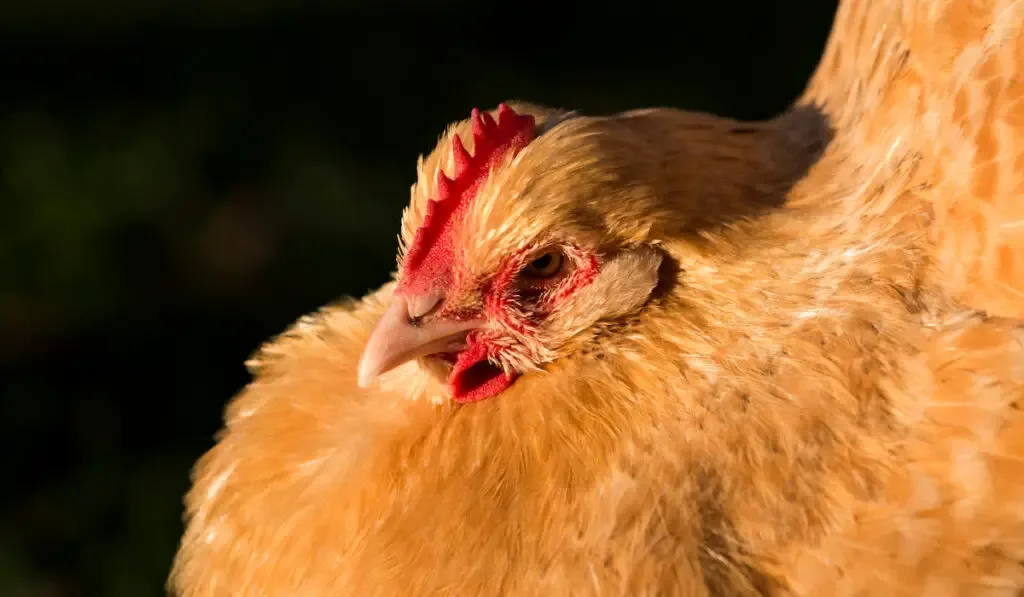
Also known as Golden Comets, Red Sex Links, Cinnamon Queens, and Boven Browns, these hybrid chickens were developed in the 1800s through a cross between the Leghorn and the Rhode Island Red.
These chickens are also sexed-linked, which means the roosters can be differentiated from the hens upon hatching. Although American Poultry Association doesn’t officially recognize these chickens as a breed, they are still unique and different from other birds.
The Golden Buff roosters possess reddish-brown plumage with a single comb, dark wings, neck, and tail feathers. The hens are different with soft buff-red plumage, smaller bodies, and short tail feathers. Mature roosters can weigh up to 6 pounds and the hens generally weigh around 4 pounds.
Beginners can choose this breed as starter chickens because of their friendly and docile temperament. Unlike other breeds, the roosters are also less aggressive with humans and able to get along with other chickens.
As prolific layers, the hens can produce up to 5 brown eggs every week, or approximately 260 eggs per year.
13. The Cornish
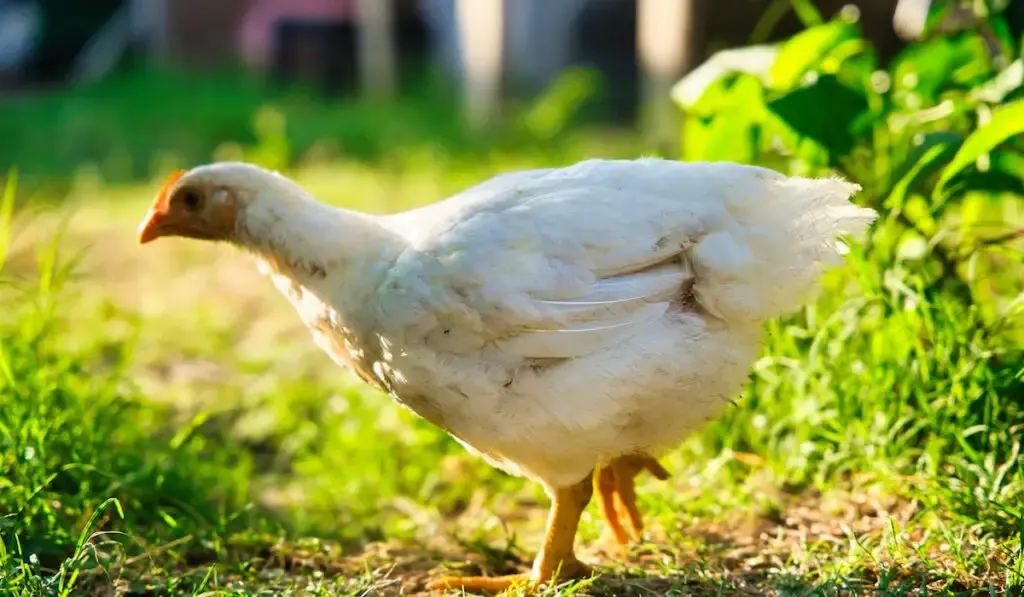
The Cornish chickens were previously known as the Indian Games before they arrived in the United States. Originating in England, they were first developed by a man named Sir Walter Raleigh Gilbert. He crossed the Red Aseel with the Black-Breasted Red Game to produce this breed.
In further development, other breeders began to cross Gilbert’s version of the Cornish with other breeds like Malay chicken, giving birth to today’s version of the Cornish.
Cornish chickens are close feathered with compact bodies that give them a clean and sleek appearance. Their feathers come in different colors like brown, green, blue, white, and buff. Roosters generally weigh around 10.5 pounds while hens weigh around 8 pounds. They also have red skin around the eyes with yellow beaks, shanks, and legs.
These chickens are beginner-friendly. They are docile and friendly toward their owners.
However, they don’t get along well with other chickens. So, it is better to provide them with separate space to avoid any territorial fight. Although Cornish hens aren’t great layers, this breed can be raised for their meat.
14. The Faverolles

The Faverolles originated from the village of Faverolles located in north central France. These chickens were developed by crossing many different breeds with each other including the Dorking, Brahma, French Rennes, Houdan, Flemish Cuckoo, and Malines.
In 1894, this breed was brought to England before being imported to the United States in 1901.
These chickens come in different varieties but only two were accepted in the United States, which are the Salmon and the White varieties.
Salmon Faverolles possess a unique coloration with white feathers on their necks and chests, a mix of gold, black, buff feathers on their bodies with iridescent green tail feathers. They also have a single, red, five-point comb, pink beaks, and feathery legs.
Roosters generally weigh around 8 pounds and hens approximately weigh around 6.5 pounds. Aside from their meat, Faverolles hens are prolific layers and able to produce around 4 light brown eggs per week.
Beginners can definitely raise Faverolles chickens because of their docile and friendly nature. They don’t mind their owners holding or hugging them. In fact, they love to be around humans and other chickens.
15. The Wyandotte
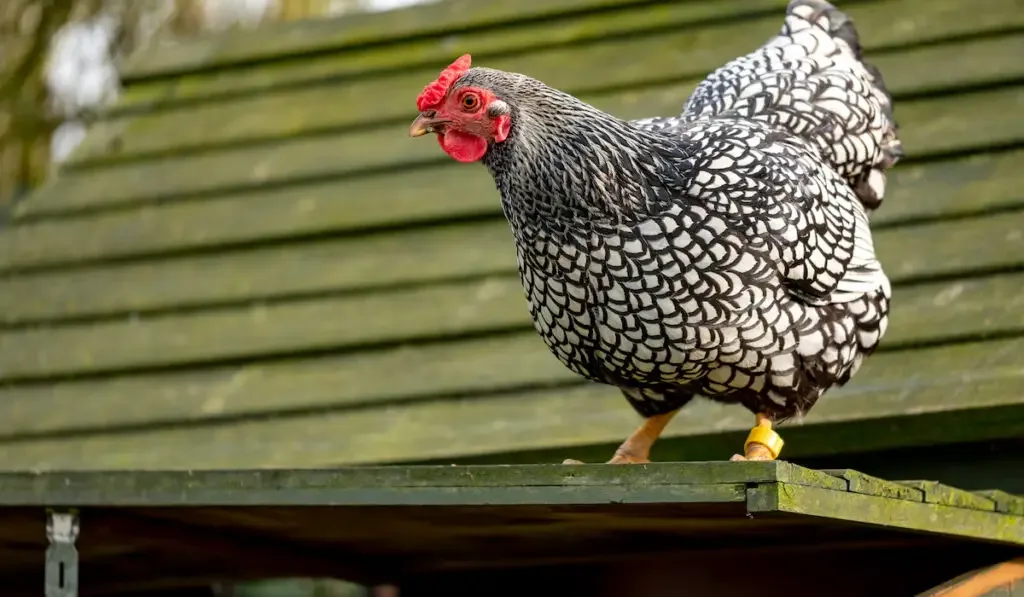
This American chicken breed was developed in the northeastern United States in the 1870s. Formerly named the ‘American Sebrights’, these chickens were made from the crossbreeding between four different breeds; the Cochin, Brahma, Sebright, and Spangled Hamburg.
In 1883, they were recognized by the American Poultry Association.
The Wyandotte chickens come in 17 different varieties but the most popular one is the silver-laced variety. These medium-sized chickens can be recognized by their large, soft feathers, rose combs, clean legs, yellow beaks, red wattles, and skins around the eyes.
The roosters generally weigh around 8.5 pounds and the hens generally weigh around 6.5 pounds. Wyandotte hens are also good layers and able to produce between 3 and 4 brown eggs per week.
These chickens are beginner-friendly due to their docile and friendly temperament. They would make good backyard chickens because they always love foraging for food on their own.
16. The Dorking

Although their origin is still unclear, some people believe that the Dorkings were first brought to England by the Romans during the rise of the great emperor, Julius Caesar.
After that, the breed was further developed in three different regions in England, Kent, Sussex, and Surrey, as a landrace. They arrived in the United States in 1870 before being accepted by the American Poultry Association in 1874.
The Dorkings are a large-sized, dual-purpose breed that comes in different color variations ranging from gray, silver, cuckoo, dark, and red. They have white skins, large red combs, yellow to dark beaks, and five-toed legs. The roosters generally weigh around 9 pounds and the hens weigh around 7 pounds.
These chickens are one of the breeds that beginners should choose because they are docile, friendly, good foragers, and easy to handle.
The Dorkings are a hardy breed and can thrive in harsh climates. Even during winter, the hens are good layers and able to produce between 3 and 4 large white eggs per week.
17. The Brahma
Also known as ‘The King of All Fowls’, the Brahmas are certainly a unique multi-purpose chicken breed. They were developed from the Shanghai breed imported to the United States and the Chittagong fowl from India.
In 1850, both Brahma and Cochin chickens gained enormous popularity and became the two most popular chickens in the United States and Great Britain.
These large chickens come in three color varieties including Light, Dark, and Buff. Brahma chickens possess fluffy, large feathers that extend down their legs. They also have large wings, large red combs, red wattles, yellow to dark beaks, and yellow legs.
The roosters could weigh up to 10 pounds and the hens generally weigh around 8 pounds. The hens are also good winter layers and able to produce between 3 to 4 medium-sized, brown eggs per week.
The Brahmas are docile and calm in nature. They are suitable for beginners that are looking for easy-to-raise chickens. Being good foragers, they also love to roam around looking for food on their own.
Final Thoughts
Whichever breeds you choose to raise, be sure they are aligned with what you want out of them. Provide every basic necessity and never forget to monitor how well they could thrive in the environment you place them in.
Lastly, shower them with love and care because like other animals, chickens are emotional creatures too.
Citations
The Leghorns
- http://afs.okstate.edu/breeds/poultry/chickens/leghorn/index.html/
- https://www.chickensandmore.com/leghorn-chicken/#Size_and_Weight
The Rhode Island Red
- https://www.thehappychickencoop.com/rhode-island-red/#Rhode_Island_Red_Breed_Standard_and_Appearance
- http://afs.okstate.edu/breeds/poultry/chickens/rhodeislandred/
The Plymouth Rock
- http://afs.okstate.edu/breeds/poultry/chickens/plymouthrock
- https://www.thehappychickencoop.com/plymouth-rock-chicken/
The Cochin
- http://afs.okstate.edu/breeds/poultry/chickens/cochin/index.html/
- https://www.thefeatherbrain.com/blog/cochin-chickens
The Easter Egger
- https://www.chickensandmore.com/easter-egger/#Personality
- https://www.thehappychickencoop.com/easter-egger/#History_and_Background_of_Easter_Eggers
The Buff Orpington
- https://www.thehappychickencoop.com/buff-orpington/
- https://www.chickensandmore.com/buff-orpington/#Appearance
The Silkie
- https://www.chickensandmore.com/silkie-chicken/
- https://www.thehappychickencoop.com/silkie-chicken/#Silkie_Chicken_Background
The Australorp
- https://www.poultryhub.org/all-about-poultry/species/fancy-chicken-breeds/australorp
- https://www.mcmurrayhatchery.com/black_australorps.html
The Jersey Giant
- https://livestockconservancy.org/index.php/heritage/internal/jerseygiant
- https://www.chickensandmore.com/jersey-giant/#Appearance
The New Hampshire
- https://www.thefeatherbrain.com/blog/new-hampshire-chickens
- http://afs.okstate.edu/breeds/poultry/chickens/newhampshirered
The Sussex
- http://afs.okstate.edu/breeds/poultry/chickens/sussex/index.html/
- https://www.thehappychickencoop.com/sussex-chicken/
The Golden Buff
- https://www.purelypoultry.com/golden-buff-chickens-p-913.html
- https://animals.mom.com/golden-buff-chicken-1676.html
The Cornish
- https://livestockconservancy.org/index.php/heritage/internal/cornish
- https://cs-tf.com/cornish-chicken/
The Faverolles
- http://afs.okstate.edu/breeds/poultry/chickens/faverolles/index.html/
- https://www.chickensandmore.com/salmon-faverolle/
The Wyandotte
- https://www.roysfarm.com/wyandotte-chicken/
- https://www.chickensandmore.com/wyandotte-chicken/#Egg_Production
The Dorking
- http://afs.okstate.edu/breeds/poultry/chickens/dorking/index.html/
- https://www.roysfarm.com/dorking-chicken/
The Brahma
